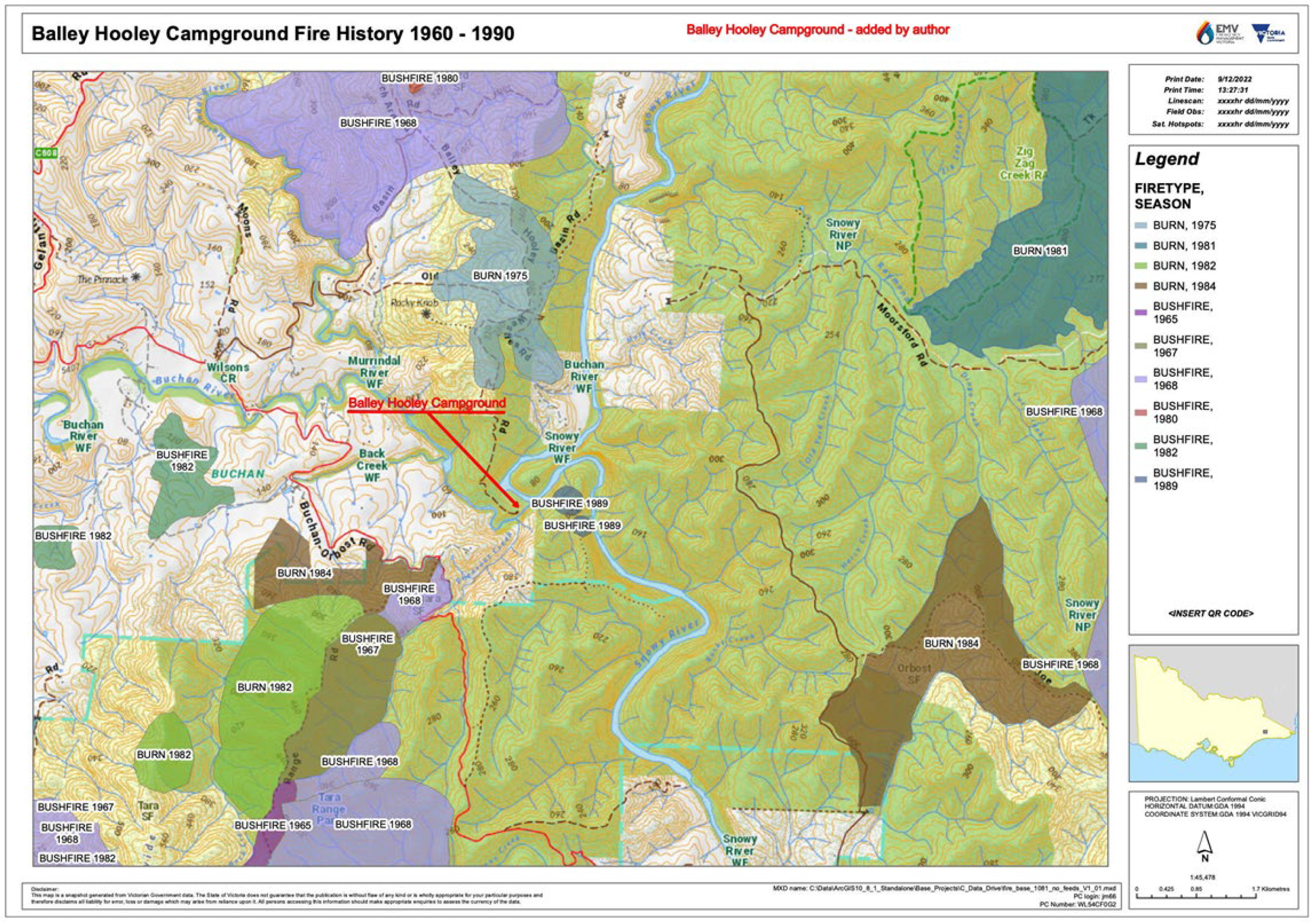Comment on Laming et al. The Curse of Conservation: Empirical Evidence Demonstrating That Changes in Land-Use Legislation Drove Catastrophic Bushfires in Southeast Australia. Fire 2022, 5, 175
1. Introduction
2. Laming et al.’s Argument
- The authors blamed the Land Conservation Act/Council for the increase in fire activity at the research site from 1970 by incorrectly claiming that “settler mimicry burning” was banned in this area at this time [4]. However, the Act did not do this [1], and the LCC did not make any recommendations for public land in any study area in 1970. Its final recommendations for public land containing the research site were published in 1983 [5], and so were implemented by the government after this time.
- The authors state in their Abstract that “Our data demonstrate that catastrophic bushfires first impacted the local area immediately following the prohibition of settler burning in 1970,…….” [4], and make other similar statements in the main text. However, information from the Victorian government’s environment department shows no catastrophic bushfires impacted the local area immediately after 1970. Also, there were bushfires in the vicinity of the research site and Buchan prior to 1970. See Figure 1: Balley Hooley Campground fire history 1960 to 1990 [6]; the research site is adjacent to the Balley Hooley Campground on the Snowy River.
3. Unjustified Generalisation of Research Findings
4. An Alternative Explanation
5. Conclusions
Conflicts of Interest
References
- Victoria. Land Conservation Act 1970. No. 8008, Government of Victoria, Australia: 1970; p. 9. Available online: http://www7.austlii.edu.au/cgi-bin/viewdb/au/legis/vic/hist_act/lca1970191/ (accessed on 2 December 2022).
- VEAC. “Victorian Environment Assessment Council Digital Archive” Victorian Environment Assessment Council, The Digital Archive Contains Published Reports and Maps of the Land Conservation Council from 1971 to 1997. Available online: https://www.veac.vic.gov.au/digital-archive/investigations (accessed on 22 June 2023).
- McPhee, G. The Land Conservation Council, Conservation or Exploitation? Walk Melb. Bushwalk. 1977, 28, 27–33. Available online: https://mbw.org.au/downloads/walk_magazine/MBW_walk_magazine_1977.php (accessed on 23 June 2023).
- Laming, A.; Fletcher, M.-S.; Romano, A.; Mullett, R., on behalf of Gunaikurnai Land and Waters Corporation; Connor, S.; Mariani, M.; Maezumi, S.Y.; Gadd, P.S. The Curse of Conservation: Empirical Evidence Demonstrating That Changes in Land-Use Legislation Drove Catastrophic Bushfires in Southeast Australia. Fire 2022, 5, 175. [Google Scholar] [CrossRef]
- LCC. Final Recommendations: Gippsland Lakes Hinterland Area; Land Conservation Council: Melbourne, VIC, Australia, 1983; p. 83. [Google Scholar]
- DELWP. Balley Hooley Campground Fire History 1960–1990, pp. Map, Department of Environment, Land, Water and Planning, Victoria, December, 2022. (The basic spatial data used to draw this map can be found). Available online: https://datashare.maps.vic.gov.au/search?md=d817f813be-a817a812-5847-9944-c5840f5842fdb39444 (accessed on 23 June 2023).
- Reviews. “Peer-Review Record of ‘The Curse of Conservation: Empirical Evidence Demonstrating That Changes in Land-Use Legislation Drove Catastrophic Bushfires in Southeast Australia’” MDPI: Fire. 2022. Available online: https://www.mdpi.com/2571-6255/5/6/175/review_report (accessed on 13 November 2022).
- Reinfelds, I.; Williams, S. Hydraulic modelling to estimate threshold discharges for sediment entrainment in the Snowy River, Australia. In Snowy River Recovery: Snowy River Flow Response Monitoring; Department of Water and Energy: Sydney, Australia, 2008; p. 45. [Google Scholar]
- Snowy. “Snowy Mountains Scheme” Wikipedia. 2022. Available online: https://en.wikipedia.org/wiki/Snowy_Mountains_Scheme (accessed on 13 November 2022).
- Erskine, W.; Turner, L.; Rose, T.; Saynor, M.; Webb, A. Bedform maintenance and pool destratification by the new environmental flows on the Snowy River downstream of the Jindabyne Dam, New South Wales. J. Proc. R. Soc. New South Wales 2017, 150, 152–171. [Google Scholar]
- Topfer, K. The Snowy Hydro Scheme and Deep Colonisation: A Call to Restructure Our Existing Resource Management Framework. p. 9. Available online: https://www.researchgate.net/publication/345986672_THE_SNOWY_HYDRO_SCHEME_AND_DEEP_COLONISATION_A_CALL_TO_RESTRUCTURE_OUR_EXISTING_RESOURCE_MANAGEMENT_FRAMEWORK (accessed on 17 November 2020).

Disclaimer/Publisher’s Note: The statements, opinions and data contained in all publications are solely those of the individual author(s) and contributor(s) and not of MDPI and/or the editor(s). MDPI and/or the editor(s) disclaim responsibility for any injury to people or property resulting from any ideas, methods, instructions or products referred to in the content. |
© 2023 by the author. Licensee MDPI, Basel, Switzerland. This article is an open access article distributed under the terms and conditions of the Creative Commons Attribution (CC BY) license (https://creativecommons.org/licenses/by/4.0/).
Share and Cite
Penna, I. Comment on Laming et al. The Curse of Conservation: Empirical Evidence Demonstrating That Changes in Land-Use Legislation Drove Catastrophic Bushfires in Southeast Australia. Fire 2022, 5, 175. Fire 2023, 6, 253. https://doi.org/10.3390/fire6070253
Penna I. Comment on Laming et al. The Curse of Conservation: Empirical Evidence Demonstrating That Changes in Land-Use Legislation Drove Catastrophic Bushfires in Southeast Australia. Fire 2022, 5, 175. Fire. 2023; 6(7):253. https://doi.org/10.3390/fire6070253
Chicago/Turabian StylePenna, Ian. 2023. "Comment on Laming et al. The Curse of Conservation: Empirical Evidence Demonstrating That Changes in Land-Use Legislation Drove Catastrophic Bushfires in Southeast Australia. Fire 2022, 5, 175" Fire 6, no. 7: 253. https://doi.org/10.3390/fire6070253
APA StylePenna, I. (2023). Comment on Laming et al. The Curse of Conservation: Empirical Evidence Demonstrating That Changes in Land-Use Legislation Drove Catastrophic Bushfires in Southeast Australia. Fire 2022, 5, 175. Fire, 6(7), 253. https://doi.org/10.3390/fire6070253




